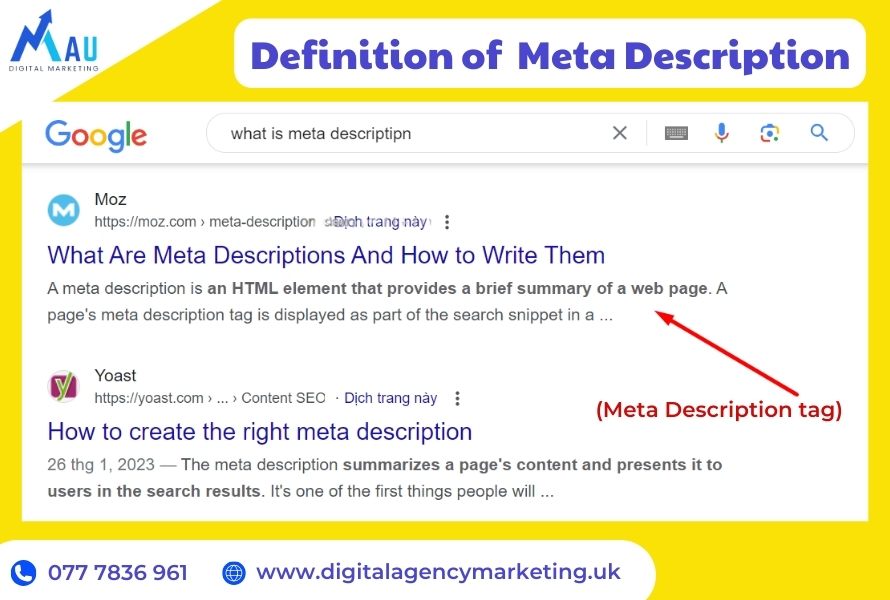8 Steps to Self-Study SEO Basics From A - Z At Home
Is Self-study Google SEO too difficult for SMEs business owners? You would like to increase natural traffic for your website but you are not proficient in Google SEO, wouldn’t you? What is the budget and time for self-study SEO? If those questions make you hesitate before learning SEO yourself. Then in the article below, MAU Agency will list out detailed instructions consisting of 8 steps for you to learn basic SEO yourself at home.
Is it difficult to learn basic SEO yourself?
The answer is yes. As a standard SEO roadmap for a website to reach the top of Google takes at least 6 months. However, to achieve that, you have to face "dozens" of terms and techniques such as: Onpage SEO, Offpage SEO, keyword SEO,...
Above all, if you are in the wrong field, you will face 6 problems when learning SEO at home. As follows:
-
Google's algorithm changes constantly and rigorously.
-
The SEO roadmap is not clear and costs a lot of money.
-
The huge amount of knowledge confuses learners.
-
There are too many reference sources and you don't know which is the reputable site.
-
The indicators are too complex for you to measure specifically.
-
Long study times make learners impatient and easily give up.
However, the above issues will be "simplified" when you know these 8 steps to learn basic SEO from A - Z right at the home of MAU Agency. And after mastering in basic Google SEO, self-learning SEO is no longer difficult for you.
→ Learning SEO yourself is not difficult, the important thing is to have passion and patience.
What do business owners need when starting to learn Google SEO on their own?
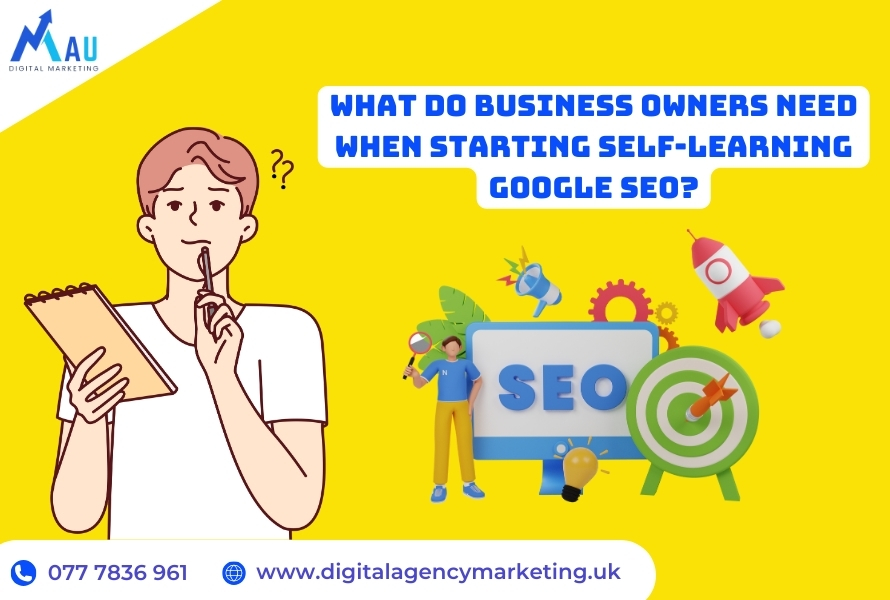
There are 3 necessary elements that people who self-study basic SEO at home need to prepare:
- Mentality:
-
Persistence and determination.
-
Passion for SEO from the early stages.
-
Always be ready. Because Google's algorithm will never stop and you have to accept and adapt to that.
-
Always have the spirit of proactively searching for information and knowledge.
-
- Tools:
-
All smart devices such as: Smartphone, Ipad,... are all tools to help you self-study SEO.
-
Must learn with practice. Therefore, you should practice the above operation Laptop or PC. It will be most convenient!
-
- Ingredient:
-
A simple website related to your business topic or product for ease of practice.
-
Prepare some basic English vocabulary because you will be exposed to many foreign documents and specialized terms.
-
Free resources from Youtube, or official SEO sites such as: SEMrush Academy, Yoast,... See more details below.
-
How much budget is needed when self-learning basic Google SEO?
With countless resources on the Internet, self-learning SEO seems to be free. So there is no limit to materials for self-study. However, with MAU Agency's experience, here are 3 reputable sources that business owners can refer to:
-
GTV SEO
-
SEODo
-
Mona Media
So that you have the opportunity to practice and experience the SEO knowledge you have learned. Then you should invest a little money to maintain the domain name for your website.
For example: Wordpress can provide you with a domain name for just under 100,000 VND/month.
Time to master basic Google SEO knowledge
It can be said that if you self-study the theory of SEO, it will only take you at most 1 month. If you want to become proficient in SEO, you have to practice continuously, and this can take a long time, at least 6 months.
Although the time to self-study SEO can be long, if you follow the following 8 steps, it can be shortened by 1 - 2 months:
Step 1: Research and analysis of competitor industries.
Step 2: Research and create in-depth keyword sets.
Step 3: Optimize website structure.
Step 4: Plan website SEO.
Step 5: Perform Onpage SEO optimization.
Step 6: Off-page SEO optimization.
Step 7: Create a Content plan for the Website.
Step 8: Analyze and measure effectiveness.
In addition, there are 2 other factors that influence the time you become proficient in Google SEO knowledge. Those are budget and perseverance.
Regarding budget, if you have a limited budget, you can still choose free resources on the Internet to learn SEO yourself. However this will give you 3 problems as follow:
-
It will be difficult for you to build a specific learning path for yourself, thereby slowing down your SEO self-learning process
-
The seemingly limitless amount of information makes you confused.
-
Another problem is that Google is constantly changing its algorithm, so selecting information is even more difficult.
→ After all, self-learning SEO is still the most important thing. You yourself must be passionate and persistent. From there, you will become proficient in the field of SEO as well as bring many benefits to your business.
Important documents to help self-study Google SEO
With MAU Agency's experience, these 5 courses which were certified by Google will help shorten your SEO self-learning process. Especially, everything is free:
- SEO for Beginners by Yoast: This is a basic course on SEO, designed to be simple and easy to understand from Yoast - one of the leading SEO Plugin companies. The course provides knowledge from basic to advanced and is a great start for those just starting to learn SEO on their own.
- SEMrush Academy: SEMrush is a leading website analysis and optimization tool on the market, widely used in the field of Digital Marketing. This course not only provides basic SEO techniques from A - Z but also provides additional knowledge about Digital Marketing, suitable for all levels from beginners to experts.
- The Beginner's Guide to SEO by Moz: This is a popular online learning platform that provides a comprehensive overview of SEO for beginners. Developed by Moz, one of the leading companies in SEO.
- Google - Search Engine Optimization (SEO) Starter Guide: A set of documents provided by Google for beginners in the field of SEO. It contains basic instructions and important principles that SEO self-learners need to know to optimize their website for search engines.
- Coursera’s Search Engine Optimization (SEO): Online course offered on the Coursera platform, specializing in SEO. This course provides an overview of the basics and effective strategies for improving your website's position on search engines like Google.
Basic concepts to keep in mind when learning website SEO yourself at home

Before starting to understand SEO more deeply, business owners need to understand 7 basic concepts to know what it is and what it will do in the process of self-learning SEO.
|
SEO On-page |
Optimize inside the website |
| SEO Off-page |
Optimize outside the website |
|
SEO Local |
Optimize impressions in the region |
|
SEO Technical |
Optimized user experience |
|
SEO Content |
Content optimization |
|
SEO Mobile |
Optimize experience on mobile devices |
|
E.E.A.T |
Increase reliability |
-
SEO On-page: Is an important part of a search engine optimization strategy, focusing on optimizing content and on-site elements to improve placement on search results pages. This includes optimizing titles, meta descriptions, URLs, and improving user experience through page load speed and page engagement.
-
SEO Off-page: Focus on optimizing off-site factors to enhance site authority. This includes building quality links from other websites, participating in social networks, and building an online reputation through sharing valuable content.
-
SEO Local: To increase the presence of a business or service in a specific geographic area. Including optimizing IP location, as well as collecting positive reviews from local customers
-
SEO Technical: Is the part that optimizes technical elements on the website to increase user experience and increase the ability to appear in search results. Includes many factors such as page loading speed, website structure, sitemap,...
-
SEO Content: Is optimizing content elements. Optimize keywords, format or content to be unique or not.
-
SEO Mobile: Optimize user experiences on mobile devices, as well as help increase impressions on search results.
-
E.E.A.T: The website needs to demonstrate experience, expertise, authority, and trustworthiness. This means the content must be written by people with deep knowledge and experience
Jump to: Google SEO optimization service at MAU Agency
Guideline for business owners in 11 steps to self-study basic SEO from A to Z
SEO is not a simple thing. Business owners not only have to create a strategy to help push their website to the top of Google search, but they also have to achieve goals such as conversion rate, traffic volume, and bounce rate. rate). With many years of experience doing SEO, MAU Agency will guide business owners with basic knowledge to help self-study SEO become more effective.
Step 1: Research and analyze the industry and competitors
The first knowledge in self-learning SEO is that you must learn about the market as well as your industry and competitors. Only then can you come up with ideas effectively and quickly. Let MAU Agency give you an example:
For example: You are the business owner of a Nails facility that needs to implement SEO. So in analyzing your competitors to prepare for the SEO self-study process, what do you need to do:
First refer to the market & industry:
-
Update aesthetic trends
-
Adding additional services according to customer needs: Nails service, foot massage service, body care,....
-
Refer to market prices and customer preferences.
Second, analyze competitors in terms of SEO:
-
Refer to their website's UX/UI presentation.
-
Evaluate your competitors' brand identity
-
Refer to their images, content, products and services.
Based on two sets of documents "Google Search Quality Evaluator Guidelines" and "Google Search Central", Google uses more than 200 elements to evaluate your SEO and Website.
Therefore, if you are new and are learning SEO yourself, please refer to the formation and implementation methods of your competitors in the Top 1 - 3 to see how they implement SEO for a keyword or the overall website. Please!.
You will take notes so that you can move on to the next steps and based on that, customize your personal project.
Step 2: Research and create an in-depth set of keywords
Let's make it easier for you to understand like this:
-
Customers search for your service or product through "Keyword"
-
Google will evaluate your website and the quality of your content by "Keyword" (Like the 200 factors mentioned above)
So what if you skip the keywords section when learning SEO at home? Don't try it!
In addition, each industry will have different sets of keywords. If you build a reasonable set of keywords, it will help your business website reach the right customers.
→ In-depth keyword research is a must have step when performing SEO.
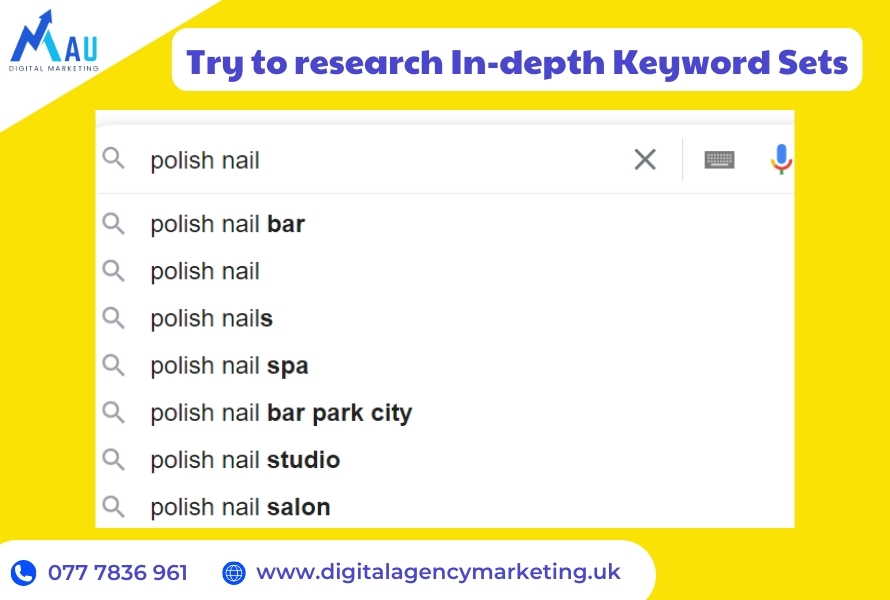
To achieve high efficiency when building a set of target keywords, MAU Agency guides you through the following steps:
1. Develop a research strategy and create keyword sets for the target audience
Your keyword strategy must be targeted to every customer, because any customer can become a target customer of your business.
You should build keyword sets targeting customer groups that want to use the service, the product of your business. And the set of keywords targets the desired customer group Learn deeply about information and knowledge related to services and products that your business provides
For example:
A set of keyword phrases "nail polish" will:
-
"Gel nail polish"
-
"where to buy nail polish"
-
"How much does nail polish cost?"
-
"nail polish bottle"
-
“cheap nail polish”
-
“how to preserve nail polish”
-
And there are more than +1000 other keywords
2. Keyword research must follow Search Intent
Search Intent is a user criterion when typing a query into a search engine. When your keywords and website content meet the criteria of Search Intent, your website is prioritized to the top.
For example:
This afternoon, you have a date with your lover. Go to Google and type in the keyword "Female hairstyles suitable for oval faces” then Google gives you two pages top 1 is A and top 2 is B. Visit website A and see it again to There are many beautiful hairstyles but not for oval faces, you exit. Switch to site B and you see 10 beautiful and suitable hairstyles for oval faces, you stay to watch and choose a hairstyle to go to the salon. Then website B is correct with your Search Intent, and many people do the same thing as you. Website B will be highly appreciated by Google and ranked at the top.
To facilitate self-learning SEO, MAU Agency gives you a little tip 3 secrets Quick research Search Intent:
-
Search bar: When you type a keyword phrase into the Google search bar, there will be many results that drop down, which is part of the user's Search Intent.
-
Heading "Other search content": If you search for a keyword and then scroll down to the middle of the page, you will see many suggestions on topics related to the keyword. That's all the users searched for.
-
Refer to the titles of the top 5 - 10 top articles: Please take a quick look at what the titles of the top articles are about!
There are 4 types of Search Intent that business owners learning SEO themselves need to pay attention to:
-
Informational Intent: Keywords for information search purpose.
For example: gel polish method; What is powder coating?...
-
Navigational Intent: Keywords used to search for a specific website.
For example: Nail course at NUKA House; Register for membership at Gloss Bar;...
-
Commercial Intent: Keywords for deeper and broader search on products and services.
For example: The most beautiful and luxurious paint color; Spa salon with good prices in Brighton;...
-
Transactional Intent: Keywords show purchase intent.
For example: "Price of gel nail steamer; How much does a set of nail clippers cost?..."
3. Take advantage of long-tail keywords
Most businesses often compete with "short keywords", this is not wrong, but the competition rate is very high and it is difficult for businesses to reach the top. Short keywords are words or short phrases consisting of 1 to 4 words that users enter into search engines
Short keyword example: nail polish, nail steamer, powder coating
Take advantage of the long-tail keyword to be more competitive. Long tail keywords are detailed phrases or questions that users enter into search engines to find specific information or solve a specific problem.
Example of long tail keywords: how to preserve nail polish; nail steamer price; dip powder nails at good prices in Manchester.
However, the search volume for long-tail keywords will not be as high as for short keywords (less than 100 searches per month). So you must balance the number of keywords in your SEO strategy.
4. Note difficult keywords
Difficult keywords are also called Keyword Difficulty is a keyword with a large search volume and is highly competitive. The difficulty scale is calculated from 1 - 100. The higher the keyword score, the harder it is to reach the top of Google.
From experience in SEO, MAU Agency will provide...Let me give you 6 websites providing tools to research and identify difficult keywords and view the rating scale.
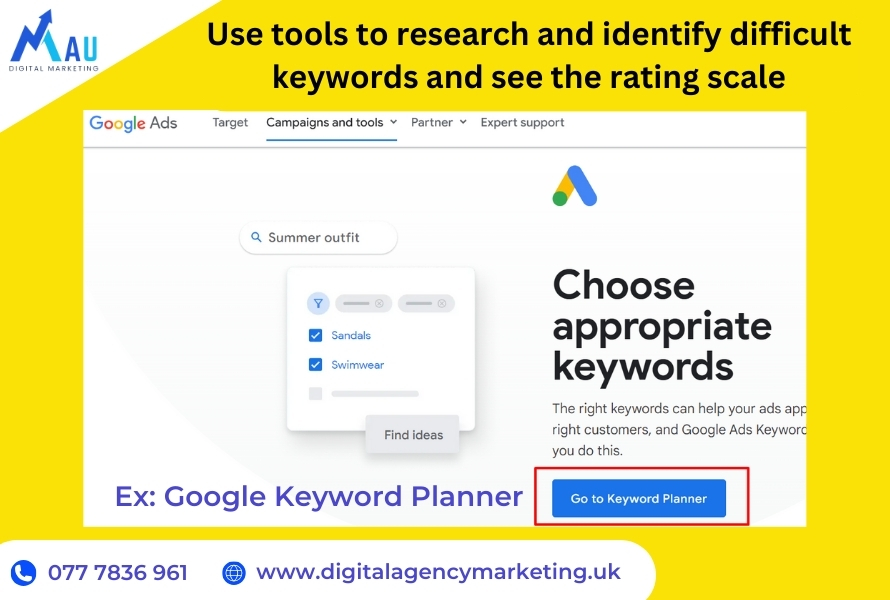
-
Google Keyword Planner: Is a tool provided by Google, designed to support users in searching and analyzing target keywords that are both suitable for running Google Ads and performing SEO.
-
Keywordtool.io: Not only supports keyword analysis but also provides users with a list of related keywords and suggested long-tail keywords.
-
Semrush: provides keyword research, competitor analysis tools and identifies industry trends.
-
Ahrefs: Ahrefs is not only a powerful keyword research tool but also provides backlink information and competitor analysis.
-
Moz Keyword Explorer: Moz is one of the leaders in the SEO field, their Keyword Explorer tool provides detailed information about keywords, including popularity and competitiveness.
-
Ubersuggest: Developed by Neil Patel, Ubersuggest is a free keyword research tool that provides information on search volume, competition, and related keyword ideas.
Step 3: Optimize the website structure
Optimizing website structure (SEO Technical) is an important factor that people who self-study Google SEO must pay attention to. Of course, if you are a self-learning person in basic SEO and don't know how to form a website structure, just follow these 3 steps from MAU Agency!
-
Step 1: Refer to the interface and brand identity of top websites. You should choose a website in the same industry.
-
Step 2: Look at: menu bar, header, footer to see what content the website contains.
-
Step 3: Please try to refer to each detailed page on that website to understand their connection. For example, when you click on the word "Quotation", a form to fill in information will appear.
From there, summarize and build page links or elements on your website appropriately, from interface, color, font to layout. Google will also appreciate your website from that.
MAU Agency shows you 6 more things to keep in mind when optimizing website structure
-
Layouts must be clear and easy to see.
-
Optimize simple URLs, containing main keywords.
-
Category optimization.
-
Optimize Favicon (Clear image of Icon, Website Logo).
-
Menu, Header, Footer, Breadcrumb must be easy to use and have a layout
-
Optimize your business's location on Google Maps
-
Meta, heading, title tags must be optimized and contain main keywords
Step 4: Plan Website SEO
Depending on the product or service industry, business owners will set appropriate goals and strategies to plan SEO for their business website.
For example:
A business that specializes in Nail Salon, does not have a website and is not ranked on Google search results. Business owners must come up with a plan to build and increase brand recognition for their Nail Salon.
Phase 1: During the first 3 months you?Prioritize Onpage SEO - Focus on building keywords and content on the business's main website
Phase 2: The next 3 months friend tImplement Offpage SEO - To increase reliability as well as build thick and strong backlinks. At the same time, create links with Social Media platforms to increase reputation on Google as well as customers.
And the time after that (from 3 months) you will continue to optimize factors Technical and Content SEO (Step 7) to make your website better and better.
Step 5: Perform Onpage SEO optimization
As emphasized at the beginning of the article, Onpage SEO is an important thing that you must pay attention to. Below are 7 easy-to-understand ways to optimize Onpage SEO that MAU Agency packages for you
5.1 Build a solid article outline
From the keyword research process, you should build yourself a set of secondary keywords to optimize your article and be highly appreciated by Google. At the same time, your outline must be carefully selected to have enough information to match the Search Intent. And that is the factor that keeps readers staying on the website longer.
So basically, you need to create an article outline with 6 elements like this:
Title: The title should be under 60 characters and contain the main keyword while also being attractive to the reader.
For example: “Ways to preserve nail polish that you should not miss"
Description (Meta Description): The description should summarize the content (under 160 characters) of the article in an attractive way and contain keywords.
For example: “How to preserve nail polish so that it is durable in all types of weather and how many ways are there to preserve nail polish?”
Introduction (Sapo): Give a short, engaging introduction to the issue being discussed in the article and contain the main keyword.
For example: “Nail polish is one of the familiar products for women, especially when they do their own nails at home. However, if not stored properly, nail polish can quickly spoil and you will have to spend more money. So how to preserve nail polish? Let's find out through the article below!
Article body (Heading 2; Heading 3, Heading 4):
-
Divide into sections/chapters with headings (H2, H3, ...).
-
Each section/chapter should focus on a specific aspect of the topic.
-
Use main keywords and related keywords naturally in the content.
For example:
-
H2: 3 Tips to preserve nail polish well and properly
-
H3: Tip 1: Place nail polish in a cool, dry place
-
H3: Tip 2: Apply nail polish properly
-
H3: Tip 3: Clean the nail polish cap with cleaning solution after use
-
H2: Should I put nail polish in the refrigerator to preserve it?
-
H2: Some notes when using and preserving nail polish
-
H3: Don't dilute your nail polish
-
H3: Replace the nail polish cap after use
Source of reference information:
-
Provide detailed and reliable information from reference sources.
-
Create internal and external links with reputable sources to improve the credibility of the article.
Summary and Conclusion:
-
Summarize the main points and emphasize the value readers can learn from the article.
-
Conclude with a brief invitation (CTA) to encourage users to take further action For example: register, purchase, schedule, etc.
5.2 Optimize Meta Description
Meta Description is a brief summary of the website below the article title. The purpose is to give users an overview of the page's content.
MAU Agency tells you 4 must-have criteria when learning to write SEO-standard Meta Descriptions
-
Meta Description contains the main keyword.
-
There are 155 - 160 characters.
-
Brief summary, showing users an outline of the main content of the article.
-
There needs to be an attractive and stimulating element for readers. For example “10 ways you must pay attention to avoid peeling paint”; "read now so you don't miss it";...
5.3 Pay attention to the Heading and Title of the article
Title is the title of the article, showing users the content of the article they will access. To optimize the title, MAU Agency shows you 4 important notes below
-
Title contains the main keyword.
-
Length must not exceed 70 characters.
-
The title must represent all the content you want to mention.
-
Prioritize numbers at the beginning of sentences. For example: "10 Google SEO Implementation Mistakes That Business Owners Need to Avoid”; “5 Nail Styles to Make You More Attractive in Men's Eyes”
Headings are small titles inside the article, representing the specific content of each section in that article. Heading will include headings 2, 3, 4,... To optimize headings, you need to note:
-
Heading must not exceed 70 characters.
-
Heading 2 should contain the main keyword and secondary keywords.
-
Heading 3 and 4 should take full advantage of secondary keywords for optimization.
-
The content of Headings must have elements that match the "Search Intent".
5.4 The URL must be friendly
Friendly URLs are shown through factors such as containing the main keyword, no accents, no capitalization, and connecting words with hyphens.
MAU Agency will suggest an example of URL so you can easily understand:
URL example: https://www.nailbeauty.com/articles/how-to-choose-the-perfect-nail-color
In this example:
-
"nailbeauty.com" is the domain name of a website about nail beauty.
-
"/articles/" is part of the link that indicates that it is an article.
-
"how-to-choose-the-perfect-nail-color" is the part of the link that describes the content of the article, suggesting it's a guide on how to choose the perfect nail polish color.
5.5 Take advantage of SEO Plugins
Basically, an SEO plugin is a tool that helps users easily optimize elements such as keywords, titles, descriptions, internal links, and other technical factors effectively to improve their performance. site location
If your website runs on the Wordpress platform, you should take advantage of SEO plugins such as Yoast SEO, Rank Math,... to support optimal article content and images. In addition, the plugins also assist you in analyzing important indicators so you can come up with reasonable strategies.
5.6 Always diversify Content
The most important thing to keep readers there is content. So you can increase traffic by implementing unique, quality content
-
Content must be of high quality, ensuring E.E.A.T
-
Content must be unique and cannot be stolen from another website (Google severely penalizes this case)
-
Optimize content to be diverse such as images, videos, infographics,... to increase viewer experience.
5.7 Note Internal Link and External Link
Internal and External Link are two important factors to increase the awareness and reputation of the website. Google also appreciates these two criteria in your website.
To optimize this, you need to pay attention to:
-
Websites used for External Links must be reputable, thereby increasing the reliability of the website
-
Limit spam Internal Links, should be placed in a reasonable number depending on the content length.
-
Use Anchor Text appropriately and naturally
Step 6: Optimize Offpage SEO
Off-page SEO is the process of optimizing outside the website, including two tasks:
-
Build Entity to increase brand recognition and website reputation. Usually takes advantage of social networking sites (Social Media).
-
Create a Link Building to optimize the website more
6.1 Optimize Entity Building
Entity can be simply understood as proving that your website is an entity that Google can identify and trust. We can optimize Entity Building by making the most of links from the website to major social networking sites (Social Media) and vice versa.
In addition, you need to take advantage of additional components in the "Google engine" such as using business mail ending in gmail.com and registering location information on Google Maps.
6.2 Optimize Link Building techniques
Link Building is the technique of pointing links from other websites to your website. Note that other websites must be reputable and of high quality. From those backlinks, Googlebot can find your website while collecting information from other websites and vice versa. Because of this, your website will increase its credibility with Google.
There are 2 types of backlinks:
-
Do-follow: When you leave backlinks with Do-follow, Googlebot will also collect information to the website pointed to from that link. If both websites are highly reliable and high quality, both will benefit.
-
No-follow: Then Googlebot will evaluate and not crawl the website pointed to. No-follow backlinks are often to reinforce information as well as expand it to readers
Reference: Digital SEO Marketing optimization service at MAU Agency
Step 7: Create a Content plan for the Website
Business owners need to note that SEO does not depend entirely on technique but it also depends on content. So if you want to bring your website to the top of Google, you must create a variety of content with attractive information and quality keywords.
With many years of experience self-studying and doing SEO Content, MAU Agency will give you a few notes as follows:
-
Content must be natural and avoid plagiarism from other websites
-
The content provided must be correct Search Intent of the user
-
The content of articles must ensure E.E.A.T factors (Experience, Expertise, Authoritativeness, Trustworthiness)
-
Image content must have captions, Alt text, etc. To be more optimal, the caption should have the main keyword
-
Do not stuff keywords or spam keywords.
→ SEO is not a technique, it is content.
Step 8: Analyze and measure effectiveness
The last but not least important job is to reevaluate the results and effectiveness of the campaign. This work must be done continuously throughout the SEO campaign to be able to evaluate and find problems so they can be improved.
8.1 Measuring SEO results
When learning about measuring SEO results, business owners need to pay attention to the following 5 indicators:
-
Traffic: Number of visitors to your website.
-
A new website usually has less than 100 visits per month, equivalent to about 0.01% of the total number of visits on the Internet.
-
Time onsite: Time the user stays on the page.
-
Most will be under 1 minute, but there are still about 20% - 30% who will stay longer than 1 minute
-
Bounce rate: Rate of users exiting the page.
-
On average, it will be from 60% to 90% for new websites
-
Page view: Number of pages viewed by the user in one visit.
-
Usually less than 10 page views per visit, depending on the richness of the content on the site
-
Session: User's website visit.
The average will be less than 50 visits per day.
The above 5 factors are all closely related and affect each other as well as the SEO score that Google will evaluate.
For example: A website has high traffic but accompanied by High bounce rate. Then that website will not be highly appreciated by Google to be ranked at the top.
You should also consider backlinks where the business website links to other websites or vice versa. Because if another website's reputation is affected, your business's website will also suffer the same fate.
8.2 Optimize and change comprehensive strategy
From regular assessments and analysis of results. You will find which areas are not strong enough, which factors negatively affect the score that Google gives your website. From there, we can plan a more effective optimal strategy
What are the benefits of learning SEO yourself?
Self-learning SEO is a long-term process that requires 3 elements: Perseverance - Determination - Meticulousness. Therefore, if you follow a methodical and professional roadmap of your predecessors. Your business will receive the following 5 benefits:
-
Cost savings: The overall SEO roadmap also costs 300 - 400 million over 6 - 12 months. Learning SEO yourself will help you save that. Free resources from the community in a variety of forms (Blog, Video,...) or courses from only 5 - 10 million VND.
-
Actively arrange your time: When you learn SEO yourself at home, your time seems to be proactively arranged by you. You will not need to wait for the right time to enter class or wait for the right time to leave like in face-to-face courses.
-
Know how a website operates: SEO requires you to clearly understand the website. Self-studying SEO helps you have in-depth knowledge of the website and understand the operating process and can optimize technical SEO factors yourself.
-
Understand customer behavior: When a customer visits your website, what do they do? Which article to read? Which product to buy? are all stored. Then you will easily reassess which of your services/products attract customers' attention, which information customers are interested in, thereby optimizing these "attracting" factors.
-
Know how to measure SEO indicators: During the process of self-studying SEO, you will also get acquainted with indicators such as Traffic, Outbound Rate, Conversion Rate,... Then with these indicators you will be able to evaluate for yourself whether your website needs to be optimized or changed. at any point
-
Proactively control SEO plans: Self-studying SEO helps you understand each job you or your business's staff needs to do to optimize the website. What direction will the content of my website be? What is a reasonable way to measure costs?
Questions that people often ask when self-studying and doing SEO at home
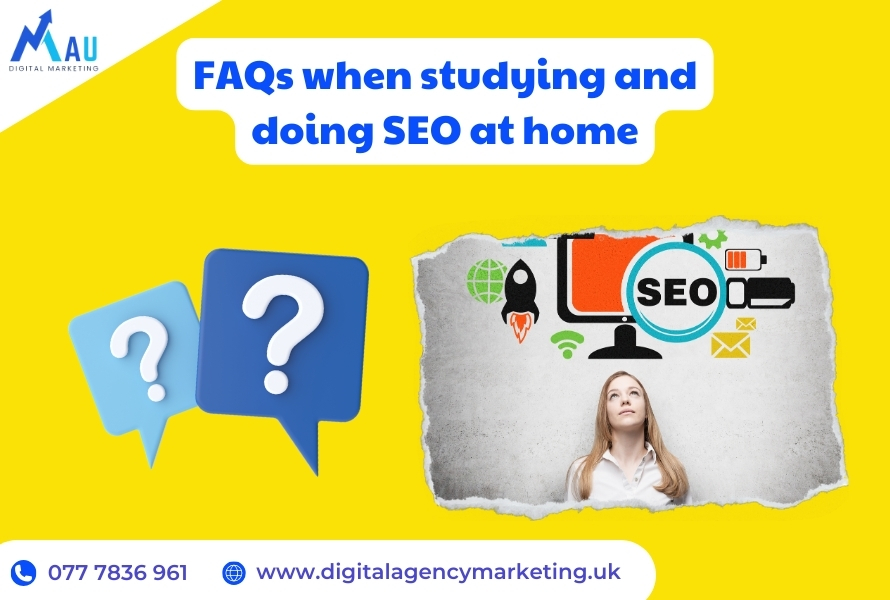
Is it necessary to regularly monitor and adjust the SEO strategy?
Yes, the SEO environment is always changing along with the algorithms of search engines like Google. Monitoring and adjusting your SEO strategy helps you maintain and improve your website's position in search results.
How to measure and track your website's SEO performance?
Use Google Analytics analytics tools to track traffic, traffic sources, and user behavior on your website. You can also use a tool like Google Search Console to track keyword position and search performance.
When should I learn to do SEO at home?
If you want to equip yourself with the skills to manage and optimize your business website or want to learn deeply about the field of Digital Marketing, improving your knowledge and skills by self-studying SEO at home is an extremely smart choice.
How long does it take to see an increase in traffic?
It usually takes a minimum of 3 months to complete updates and re-index a website before it begins to see a noticeable increase in traffic.
How many factors does Google use for ranking?
According to Google Search Central documents, there are more than 200 criteria to evaluate the ranking of websites: E.E.A.T, Entity, Pagespeed, Core web vitals, Search Intent,….
Conclusion
Self-learning SEO is not a simple task, takes quite a bit of time and requires a lot of patience. However, once you have mastered basic Google SEO knowledge, it brings many benefits to yourself and your business. We hope that MAU Agency's knowledge and many years of experience doing SEO will help you in the process of self-learning website SEO at home.
The author has consulted information from the following sources:
-
Search Intent and SEO: A Complete Guide. (2019, July 18). Backlinko; Backlinko. https://backlinko.com/hub/seo/search-intent
-
What Are Meta Descriptions And How to Write Them. (2024). Moz. https://moz.com/learn/seo/meta-description
-
Warren, T. (2023, April 6). Entity SEO: The definitive guide. Search Engine Land. https://searchengineland.com/entity-seo-guide-395264
-
What Is SEO - Search Engine Optimization? (2023, December 6). Search Engine Land. https://searchengineland.com/guide/what-is-seo
-
SEO Starter Guide: The Basics | Google Search Central. (2024). Google for Developers. https://developers.google.com/search/docs/fundamentals/seo-starter-guide
--------------------
DIGITAL AGENCY MARKETING UK
Add: 133 Creek Road, London SE8 3BU
Tel: 077 7836 9618
Email: admin@digitalmarketingagency.uk
Website: https://digitalagencymarketing.uk/
Tin tức khác
10 Comprehensive Steps to Craft an SEO Strategy and Dominate the Market in 6 Months
Pricing 10+ Type of SEO Cost That Business Owners Should Pay Attention
Top 10+ SEO KPIs | 6+ Determination Steps, 5 Notes, 4 Benefits You Cannot Skip
Can Business Owners Become SEO Experts?
Top 10 SEO Mistakes Business Owners Need to Avoid

